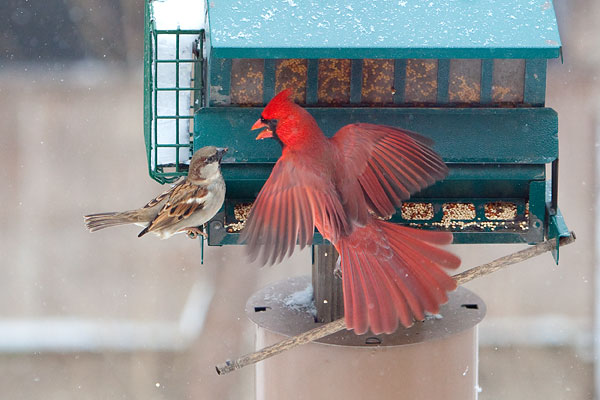
Posted on 02/18/2018 10:07:42 PM PST by nickcarraway
Have you heard of “bird feeder fight club”? If not, that’s probably because I just made it up. But it totally could be a real thing, according to scientists using Cornell’s vast Project FeederWatch data set.
Feeder Watch is one of several bird related citizen science projects managed by Cornell University’s Lab of Ornithology, which also include eBird and Nest Watch. More on those projects another time, but I will say that if you are not using eBird yet, you should be.
The brilliance of these projects is that they harness the collective observational power of hundreds of thousands of ordinary people to produce data that is useable by researchers all over the world. And scientists have produced a mountain of peer-reviewed research with the data. According to the lab, over 150 scientific papers have used data from these projects since 1997, looking at everything from the effect of invasive species on native birds to the epidemiology of an eye disease affecting House Finches. An old grad school buddy of mine, Ben Zuckerberg, has made a cottage industry out of using Project FeederWatch data to study the effect of climate change on bird distributions.
But a collaborative of university scientists recently published what may be the coolest FeederWatch study of all. They looked at bird interactions at feeders to determine which species tend to win when it comes to bird on bird fights over food. While I’m sure they just wanted to look at a whole bunch of bird fights to see who is toughest, in order to get published they included some high-end math, as well as appropriately sciencey language like the following sentence: “Pagel’s lambda varies from zero to one, where one indicates that variance in dominance is well predicted by a Brownian motion model of evolution.” Got it?
Despite that muddy language, the results were fairly intuitive in that size generally predicted dominance. But, there were several surprises. It turns out that woodpeckers are even tougher than their size would indicate. Though I guess it’s not that surprising that a bird with a chisel bill and a jackhammer neck would do pretty well in backyard brawl. Plus, I can’t imagine a Tufted Titmouse is all that tough of an adversary. Woodpeckers also have special skull and bill adaptations that allow them to repeatedly smash their bills into a tree at high velocity without sustaining brain damage, meaning that, unlike human fighters, they are essentially concussion proof.
There were also some interesting three-way species dominance relationships that sounded more like a game of rock-paper-scissors, as pointed out by Rachel Lallensack writing for the journal Science. When all three species were present, House Finches dominated Purple Finches, who dominated juncos. But, in a real head-scratcher of a twist, Juncos dominated House Finches.
I don’t know what you guys are seeing in your yards, but my feeders seem disappointingly tranquil in terms of bird fights, and my woodpeckers mainly manifest their violent tendencies on my cedar shingles. Nevertheless, based on this research, I wouldn’t want to meet a Downy Woodpecker alone in a dark alley. If you watch birds at your feeder, and can do two hour-long observations each week, then you’re the perfect candidate to contribute data to Project FeederWatch. If your feeders are particularly busy, make some popcorn, pull up a chair, check out those feeder fights and document who wins. If things get boring, find a partner for a spirited game of House-Finch-Purple Finch-Junco to pass the time. And, of course, don’t forget to calculate Pagel’s lambda – confirmation of the Brownian motion theory of evolution depends on it….
Yeah, I’ve about given up on the bird feeders because of rats.
Not to mention squirrels, chipmunks, possums, and raccoons.
Like liberals? Yea, we have that problem too. Mostly the little birds rule the day.
I have a three tiered deck. My feeder and suet cake hang from the joists of the above deck. And far enough away from the supporting posts. And far enough from the edge, that they can’t climb down from above, or jump to it.
It took time to find the right distance.
I also use bare 12GA copper electrical wire to suspend them. Strong enough, thin enough; no braiding of the wire and no sheathing.
The feeders are just off the kitchen sliding glass doors about six feet. Hours of avian entertainment.

I’ve been cautioned against using rat poison, because if our dog eats the dead rat, thereby ingesting the poison himself, it’s a minimum $1,000 vet bill to save him.

Believe it or not, once we removed the food source, the rat family relocated.
Hopefully there will be more owls around this year.

I was watching my feeders one morning when a female cardinal started screaming and thrashing wildly.she all of a sudden disappeared into the feeder.l ran over to discover an oak snake got into the feeder and sucked her into it! Separated the two unharmed and sent them on their way a great distance apart!
Woah. Was that a rat snake or a viper? If the viper, I would have separated myself a great distance apart too.
Thank you very much for the assistance! Much appreciated!
Correct it belongs to the rat snake family.we always called them oak snakes due to where you normally see them.dark grey in pattern.most other types I use to see regularly have disappeared from habitat loss.when pivot use became prevalent then came the bulldozers and trackhoes.lost a lot of forest.
Yeah, big gamer...! :-)
(I poison these bastards 24X7)
Disclaimer: Opinions posted on Free Republic are those of the individual posters and do not necessarily represent the opinion of Free Republic or its management. All materials posted herein are protected by copyright law and the exemption for fair use of copyrighted works.